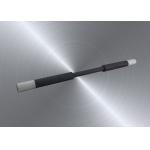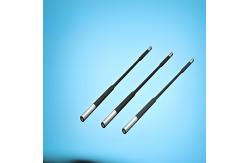DB ( Dumbbell ) Type Silicon Carbide Heating Element for Furnaces
The silicon carbide (SiC) heating element is a key component in
many high-temperature applications. Its non-metallic nature gives
it several advantages over traditional metallic heating elements.
The use of ultra pure green hexagonal silicon carbide as the main
material provides excellent thermal conductivity and resistance to
high temperatures.
The manufacturing process of making billets and silicon crystals at
2400 °C results in a product with high structural integrity and
stability. In an oxidizing atmosphere, the ability to operate at
1450 °C is a significant advantage, as it allows for use in a wide
range of industrial processes. The long continuous service life of
2000 hours indicates its reliability and durability.
The evolution of dumbbell shaped components with enlarged cold ends
is an interesting aspect of heating element design. The initial
design was aimed at reducing the cold end temperature by increasing
the cross-section and reducing resistance. However, modern
technology has made it possible to achieve terminal cooling through
other means. The reduction in electrical resistivity of the cold
end material has eliminated the need for oversized cold ends. Non
dumbbell or ED type components offer a more streamlined and
efficient design.
From a technical perspective, these developments in heating element
design reflect the continuous improvement in materials science and
manufacturing processes. As technology continues to advance, we can
expect further enhancements in the performance and functionality of
silicon carbide heating elements.
| Diameter | 9mm |
| Shape | Rod |
| Resistance | 1.2Ω |
| Maximum Temperature | 1500°C |
| Power | 1.5kW |
| Hot Zone | 150mm |
| Application | Furnaces |
| Cold Zone | 150mm |


